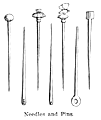Acus
dim.
Acicŭla (
βελόνη, βελονίς,
ῥαφίς). A needle, a pin.
We may translate acus
a needle, when we suppose it to have had at one
end a hole or eye for the passage of thread; and
a pin, when, instead of
a
 |
|
Needles and Pins.
|
hole, we suppose it to have had a knob, a small globe, or any other enlarged or
ornamental termination (cf. Pollux, vii. 42; x. 136).
The annexed figures of needles and pins, chiefly taken from originals in bronze, vary in
length from an inch and a half to about eight inches.
Pins were made not only of metal, but also of wood, bone, and ivory. Their principal use was
to assist in fastening the garments, and more particularly in dressing the hair. The mode of
plaiting the hair, and then fastening it with a pin or needle, is shown in the annexed figure
of a female head, taken from a marble group which was found at Apt, in the south of France.
The hair-pin was called
acus crinalis or
acus
comatoria (
Petron. 21).



